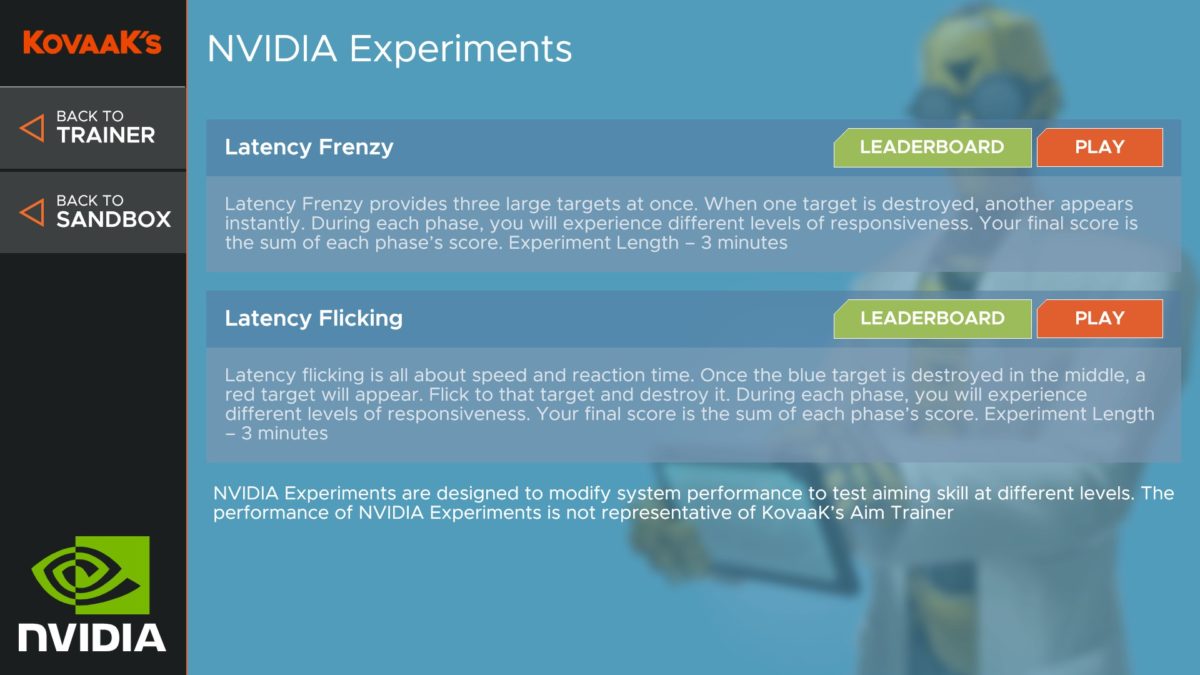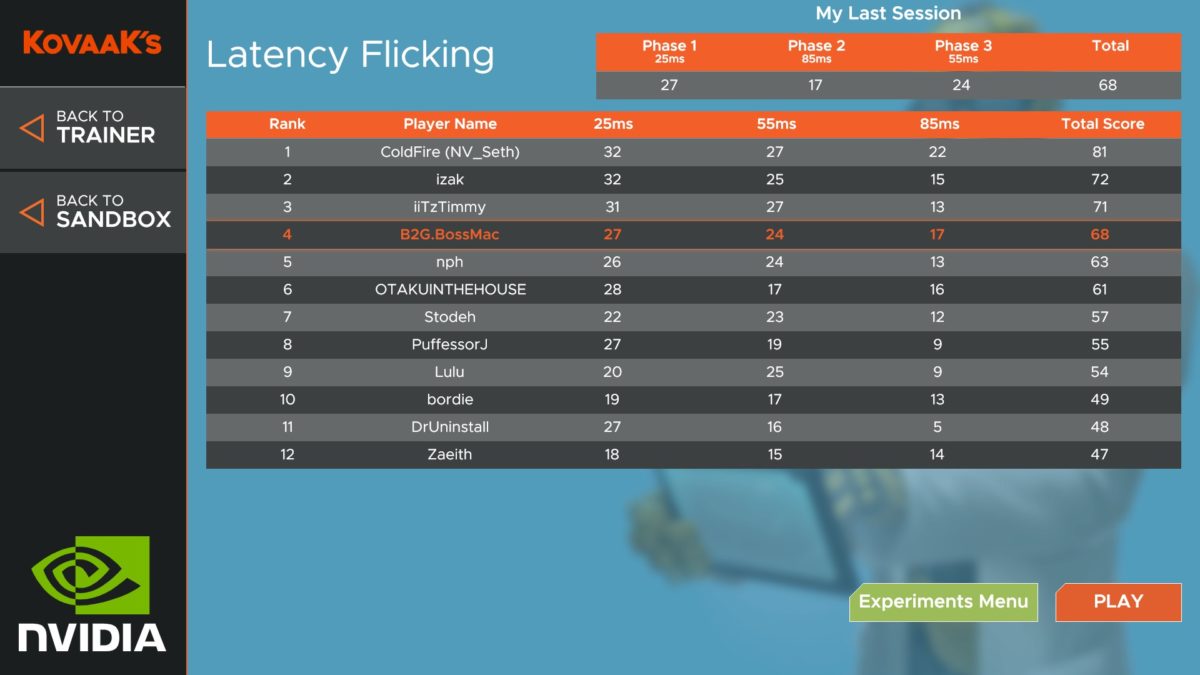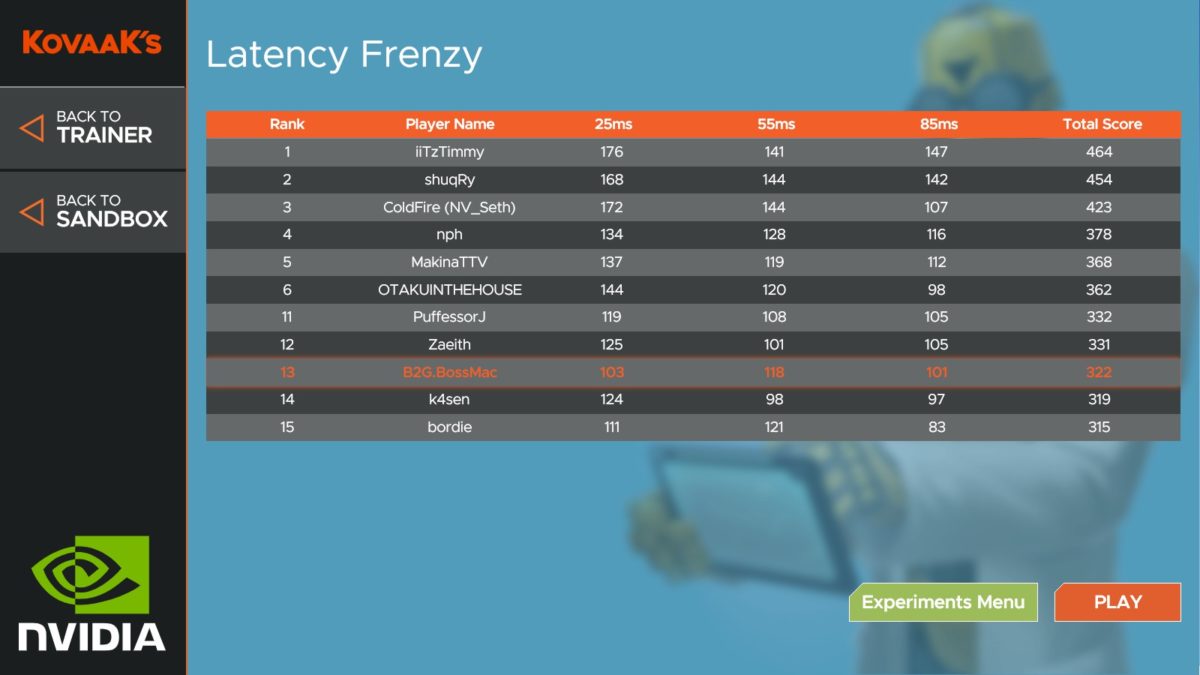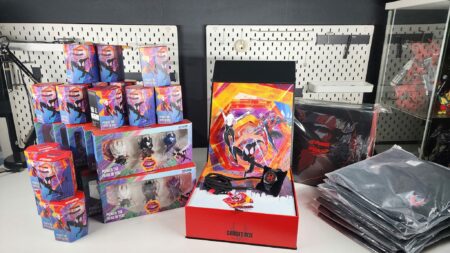We’ve discussed system latency in detail in a deepdive before but just like FPS or frametimes, numerical dimensions are but an indicator of what to expect but system latency is a simpler metric, despite being impacted by multiple layers that influence it, is actually quite easy to gauge.
That said, to better accentuate this and show people how big of an impact system latency is especially for competitive, esports gamers who may be being held back skills-wise by a system that does not compliment their skill level. NVIDIA is collaborating with The Meta, creator of the aim training game KovaaK 2.0, to announce the NVIDIA System Latency Challenge.
The System Latency Challenge aims to accomplish 2 things: first is to exemplify thru actual, practical scenarios how a system that are falling under certain latency thresholds would play. The other goal is to compile player data to reinforce this metric is a legitimate dimension particularly for any gamer that is looking for the maximum responsiveness from their system especially for competitive play. This data should prove invaluable to all parties involved, not just NVIDIA. This includes the players and product vendors alike with the data serving as good benchmark of how to really gauge a reliable esports system.
KovaaK 2.0 NVIDIA System Latency Challenge

Starting December 14, 2021, KovaaK 2.0 will run a free week where the game will be accessible and NVIDIA is inviting everyone to try the System latency Challenge within the game. If you’re asking if you can play the challenge while on AMD or Intel graphics (discrete or IGP) the answer is yes you can, but be aware that since these graphics card do not support NVIDIA Reflex, you results will not be official and thus won’t support the technical aspects of the challenge. More on this later.
The challenge consists of two parts: Latency Frenzy and Latency Flicking.
Latency Frenzy employs 3 targets down range, ever spawning after 1 hit so there are always 3 targets at any given time. Players need to take down targets as fast as they can within the given time. Players are allotted 3 shorts per clip, each proper takedown reloads the clip by 1. Miss 3 shots and the gun goes into cooldown. This is to encourage accurate shooting rather than spraying the targets with a larger clip. Relating the experience to actual FPS games, this can be likened to shooting with Mc~ I mean Cole Cassidy’s revolver in Overwatch or any high calibre sidearm in games like Rainbow Six Siege.
The exercise is quite fun and is a classic range shooting practice. The biggest difference maker here is that NVIDIA will clamp down on the system latency and will simulate 25ms, 55ms and 85ms system latency to give the players the experience of playing on systems running these numbers. Now as I’ve detailed in my System Latency article, system latency itself is not as simple as lowering framerates to drive frametimes down, that’s just simply not how system latency works. System latency is a measure of how fast your input goes to your PC, get processed and get responded to by the display. In the most simplest description, it is purely the click-to-photon time of a system wherein you mouse has input latency, your CPU has render latency and your monitor has display latency. Combine all of those and you have system latency.
An 25ms system latency will feel very smooth, 55ms not so much and 85ms will feel very entry-level. Now most gamers will have different reactions to this. For example, I do fairly well at 55ms but 25ms I am still acclimating to. At 85ms, its bearable but not something I enjoy. Of course if you’re a twitch shooter that clicks on anything that moves, you’re going to fare quite well here especially if your aim skill can match your sensitivity.
These are the current beta scores featuring internal NVIDIA staff and content content creators. Scores are tallied from all 3 sets of scores. The better you do on all 3, the better your score.
The other game is Latency Flicking. A center target pops up in the middle of the range and the goal is to flick the red targets across the range, popping them during the flick in one shot which leads to a score. The player is encouraged to return their aim at the middle and then flick to another target.

This exercise emphasizes the potential accuracy that better system latency allows. In this test, you can see my score is a bit better at 25ms and is closer to my 55ms. I will admit I do not like flicking as its not just my shooting discipline so the scores here isn’t really flicking but me just scanning really quick. The game will have a red target up by 600ms after popping the blue target, roughly half-a-second to acquire and eliminate your target.
While Latency Frenzy is more fast-paced, Latency Flicking is more technical. Both shooting challenges though does have different system latencies simulated in each phase e.g. your first phase can be 55ms, second is 25ms while the last is 85ms and variations thereof.
Again, the goals are simple: to give an actual, own-system demo of what system latency plays like and secondly, to gather information for further study into the system latency dimension and how it impacts player accuracy.
System Latency Challenge Rewards

To reward gamers who will participate and complete either Latency Frenzy and Latency Flick challenges, they will automatically be entered into a global raffle. Winners will be drawn in January 2022 and prizes will be shipped on February. The prizes include:
- 9 winners of 1 NVIDIA GeForce RTX 3080 Ti Founders Edition
- 9 winners of 1 Oculux NXG253R 360hz NVIDIA G-Sync Monitor
- 9 winners of 1 Logitech Pro X Superlight gaming mouse
Technical Details
How is KovaaK 2.0 simulating latency?
NVIDIA Reflex can replicate system latency thanks to KovaaK 2.0 being an ultralight game and will easily run on 100+ FPS on very light machines with an IGP. That said, NVIDIA Reflex can inject the necessary amount of delay through the pipeline to induce the delays needed. You will need to be on a very crap PC to run slower than what KovaaK 2.0 can natively deliver.
Do take note that this is only done on Reflex-compatible systems e.g. GeForce GTX 900 or newer, so your GeForce GTX 700 or older, AMD Radeon RX 6000 or older, or Intel HD Graphics XE or older, will not be able to simulate this hence you will be running on your default system latency. As mentioned you will not be able to join the leaderboards when using any other system.
Is there a system in-place to curb cheating?
The Meta will manually remove scores performed thru unnatural means.
Do I need to make a purchase?
No purchase is necessary unless you want to buy KovaaK 2.0 to own. Starting December 14, KovaaK 2.0 will hold a free-to-play week and the System Latency Challenge will be open under NVIDIA Experiments. For those that already own the game, the challenge will be available on the December 14.






